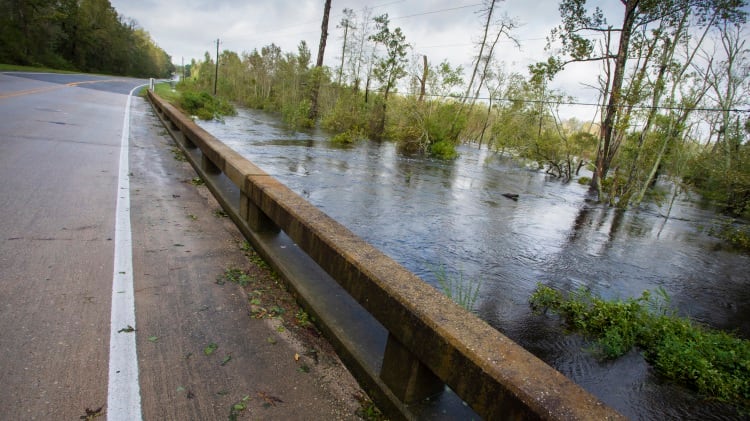Adverse environmental and health impacts caused by North Carolina’s pig manure lagoons are rapidly becoming significant risks for investors in the intensive livestock farming sector.
This was a disaster long in the making.
The damage caused by Hurricane Florence in North Carolina’s agriculture sector – home to 9.7 million pigs and 800 million chickens – has been devastating. Media stories now abound, with images of floating animal carcases, of an estimated 3.4 million chickens and 5,500 pigs drowned by Florence.
There has also been a considerable human health cost. Even in the wake of Florence, there was considerable attention paid to the storm’s impact on the state’s infamous hog lagoons, described by the New York Times as “a mixture of water, pig excrement and anaerobic bacteria”. It is reported that at least 110 lagoons have either been breached or are at risk of breaching from the floodwaters – threatening the health of surrounding communities and waterways.
This extreme weather event is shining a national spotlight on intensive farming practices, and the environmental and social risks they create. As climate change continues to develop, events such as hog waste pollution are likely to increase in frequency and severity, says the New York Times report, and investors are concerned that animal protein companies are not doing enough to manage these risks.
From lagoons to lawsuits
In August, a federal jury ordered that a payment of US$473 million be paid to several North Carolina residents who live near a pig farm owned by Smithfield Foods, the world’s largest pork producer. A chief accusation was that the industrial-scale hog-farming tarnished their quality of life by exposing them to putrid smells, buzzards, and swarms of flies from lagoons storing millions of tonnes of hog waste.
This is the third million-dollar nuisance lawsuit that the company has lost this year, according to the Wall Street Journal, with 23 more lawsuits reported to be in the pipeline, Smithfield seems not only exposed to a potentially costly stream of litigation, but may also risk damaging its reputation.
A key environmental impact of intensive livestock farming is the creation of concentrated animal waste streams (from manure and animal by-products) that require disposal. Manure can be an important soil nutrient, but the scale of intensive farming today produces quantities in significant excess of what can be absorbed by the surrounding environment.
According to the US Centers for Disease Control and Prevention, manure from concentrated animal feeding operations contains contaminants (including nutrients such as nitrogen and phosphorus), pathogens (such as E.coli), growth hormones, antibiotics, chemicals (used as additives to the manure or to clean equipment), animal blood, silage leachate (from corn feed) or copper sulfate (used in footbaths for cows). In North Carolina, this manure is stored in lagoons sprayed onto nearby fields. The hog industry alone produces over 10 billion gallons of manure annually. (Pollution from poultry operations is extensive, but the state’s environmental agency does not monitor waste disposal from most poultry farms.)
There have been numerous concerns raised about the impact of the industry’s practices on local water bodies and respiratory health. A Duke University study, published by the North Carolina Medical Journal in September 2018, showed that communities living next to hog farms were characterised by poor indicators of health linked to their proximity to these farms.
Florence has now exacerbated the issue as it has breached and overflowed many swine-waste lagoons. In one report, industry representatives noted that the judge in all three of the Smithfield cases said people who had moved to North Carolina’s rural communities were able to sue farmers for doing “nothing more than simply farming”.
The problem goes beyond North Carolina
As companies expand production, risks from waste and water pollution are accumulating. A systemic failure to manage these risks will mean that existing facilities face community protests and, as the Smithfield cases demonstrate, costly lawsuits. Companies may even be blocked from building new facilities.
Intensive livestock farming companies’ social licence to operate, or communities’ acceptance of companies’ operations, is an emerging risk, as evidenced by recent protests faced by companies such as Tyson. The company was unable to proceed with a planned $320m chicken processing facility in Tonganoxie, Kansas after protests from residents, and had to find an alternative location in Tennessee. The $320m facility represents 30% of Tyson’s 2016 total capital expenditure. In Iowa, which has 10,000 intensive farms, lawmakers are seeking a moratorium on building or expanding concentrated animal feeding operations until the state’s list of impaired waterways shrinks from 750 to fewer than 100.
This is not a problem confined to the US. In the Netherlands, the world’s fifth-largest exporter of dairy products, a new campaign by non-profit organisation WWF is calling for a 40% cut in the number of heads of cattle within 10 years. In addition, New Zealand, one of the world’s largest dairy exporters, has seen a series of clashes between communities and the dairy industry over water pollution.
Investors now have a tool to understand and manage these risks
Investors are slowly recognising these issues as investment risks. They now have a new tool to scrutinise company practices: the Coller FAIRR Producer Protein Producer Index, published by the FAIRR investor network, assesses the environmental, social and governance practices of 60 of the largest livestock and aquaculture companies in the world including WH Group, Smithfield’s parent company.
The index has identified waste and pollution as one of the biggest risks facing investors in the sector and shown that 75% of companies (excluding aquaculture firms) fail to report on their management of animal waste. No North American company in the Coller FAIRR Index mentions manure management, a significant reporting omission for an industry that produces billions of gallons of animal waste every year.
To date, there has been no noticeable impact on share performance from news of the three successful lawsuits and the potential for more to come. However, as the meat and dairy industries expand to meet global demand, and climate change makes extreme weather events like Florence more likely, environmental and health risks will only snowball unless companies shift to more sustainable production choices.
*Editor’s note: The views and opinions expressed in this piece are those of the author and do not necessarily reflect the position or views taken by GlobalMeatNews.




